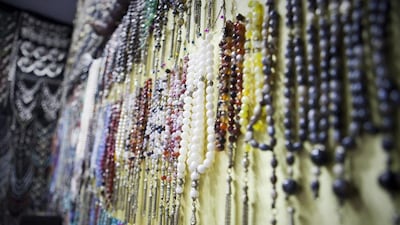Fat, golden brown amber, the brightest Iranian turquoise and pure black coral.
The subha or misbaha, prayer beads or worry beads, or any one of the other names they go by in the Middle East, hang proudly in the windows of Madinat Zayed Shopping Centre’s jewellers, a welcome burst of colour amid a sea of gold.
Used by some people when praying and influenced by Islam in their design, for many, the beads are a way to relax, to switch off from the world.
Search through the crowd and you will see them; poking out of a pocket or wrapped loosely around a hand, their owner absent-mindedly moving each bead back and forth with their thumb.
Search, and you will on occasion find them dangling from the rear-view mirror of a vehicle.
From sentimental value to helping people relax, worry beads are a comfort to many, says 34-year-old Jalal, a Yemeni expatriate, whose family business, in the capital, is home to a sizeable collection.
“People like them because they help them concentrate. Others like them because of their sound. Some people believe that they help them reach a spiritual state of mind,” says Jalal.
Tucked away in individual fraying red and gold bags, others packed in bunches, the shop sells beads of green amber, black coral and garnet among others ranging in prices from a few hundred dirhams to thousands depending on the stone, age and number of beads.
Subha made from blue or yellow amber normally command the highest prices, and the best amber, Jalal says, comes from Russia and Germany. For yusr (black coral) one should never stray far from Yemen or Saudi Arabia and the best wooden beads are sourced from Sudan.
Other materials used for subha include pearls, ivory and rose petals.
Despite their everyday presence in the Middle East, and throughout the world, there are many theories about their origins.
In Islam, a string of 99 beads represents each name of Allah. While subha consisting of 33 beads relate to a hadith that calls on Muslims, after they have prayed, to repeat subhanallah (glorious is God) 33 times, alhamdulillah (all praise be to God) 33 times and Allahu Akbar (God is great) 33 times.
The very name, misbaha, means praise to God.
Whatever their backstory, worry beads allow Najib, “a jeweller from a jeweller from a jeweller”, time to put his mind at ease.
“You’re transmitting your feelings, thoughts into this thing. It forbids you from thinking. You try it one time, whatever worry you have, you feel worry-free. That is the secret. That’s why I always have,” he says, as he reaches into his jacket pocket for a string of beads, “these”.
Brandishing a small set of murky yellow beads, although the amber is not perfect, he says, it comes pretty close.
“Amber is the queen of misbaha. It’s the queen. For whomever knows about this [worry beads], he knows the best quality is amber,” says Najib, who spends most of his working days at a jewellery shop in Madinat Zayed.
But, despite their beauty, they lack in comparison to those made by hand.
“They used to be handmade,” he says forlornly. “Now, nothing is handmade. Nothing is handmade anymore.”
And for those who want to keep up the practice, times have changed. “They will starve. Now, the game is totally different.”
Old, Jalal agrees, is always better. “It was genuine, 100 per cent. It wasn’t fabricated or fashioned. Today, it’s difficult to find genuine beads. You must be very experienced to distinguish fake from genuine.”
Real amber, when rubbed between the thumb and forefinger, will give off the smell of pine-tree resin. At Madinat Zayed, some sellers provide certificates of authenticity for amber beads. Najib, who has owned countless sets of beads in his lifetime, finds them all “excellently soothing”.
“You give your fingers a reason to move. Can you imagine me doing this without anything?” he says, as he drops his beads on the table and, smiling, wiggles his hand in the air.
“I would look crazy.”
Other precious stones used include agate, Dalmatian stone and, if you have the funds, diamonds.
The fanciest of diamonds, or the simplest of stones, it does not matter, says Najib.
“Look, there is a philosophy behind worry beads. Whoever owns worry beads, it is a sign that I am a worry-free man.
“Kind of.”
Zaineb Al Hassani is a news editor at The National.

